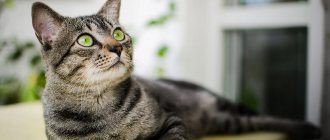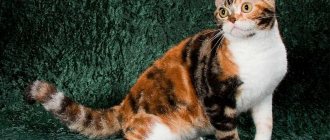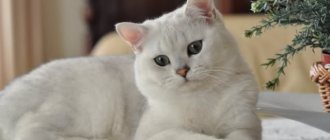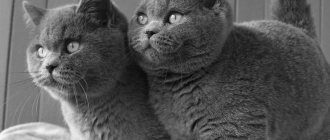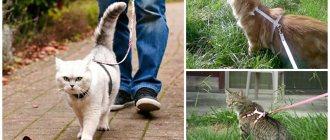History of the American Shorthair cat breed
American Shorthair
There is a wonderful legend associated with the origin of the American Shorthair. It says that Christopher Columbus, planning to go in search of mysterious India, ordered cats to be taken on all the ships of the flotilla. According to the famous navigator, this measure would save sailors from the need to fight rodents that caused damage to the food they took. This is how the ancestors of American shorthair cats came to Indian lands in the 15th century.
Unfortunately, this legend is not documented, which cannot be said about the widespread version of the origin of the breed. The first cats, which may have become the ancestors of the “Americans,” appeared in the New World at the beginning of the 17th century along with a group of English Protestants. They arrived in America on the Mayflower and founded Jamestown, the first British settlement. This is evidenced by entries in journals that have survived to this day since 1609.
Once in a different climate, animals were forced to adapt to new living conditions. The size of cats has increased in comparison with their European counterparts, and their fur has become stiffer and thicker. While whiling away their days on farms and ranches, near houses and barns, the ancestors of American Shorthairs could increasingly boast of good health. The settlers took notice of this and soon began to value the “stability” of the animals along with their excellent skills in exterminating rodents.
Until the beginning of the 20th century, breeding of cats took place in free conditions: no one cared about the exterior and purebred pedigree, or made any attempt to standardize the breed. The ancestors of the “Americans” retained similarities with their British relatives, but were distinguished by a more elongated and athletic physique. In addition, the animals were hardy, intelligent and fearless, which made them valuable material for breeding. Soon, US breeders realized that they needed to preserve the breed. Thus began the breeding of American Shorthair cats.
American shorthair kitten
Fans of these amazing animals began to acquire outstanding representatives of the breed and form ideal breeding pairs. This would allow the cats to maintain their remarkable appearance and docile nature. In 1904, the CFA registered Buster Brown, a direct descendant of the “British” who came to the United States with the colonists. From that moment on, American breeders developed a clear cat breeding program.
Its results became clear by 1930, when, with a relatively small number of generations, it was possible to “enrich” the breed with many remarkable colors. Among them was silver – a legacy from the Persians. Breeding American Shorthair cats also played an important role in the lives of their brothers. With the participation of these animals, it was possible to create new breeds: Snowshoe, Bengal, Scottish Fold, Ocicat, Bombay, Devon Rex, Exotic, Maine Coon, etc.
In the middle of the 20th century, CFA members published the first catalog, which included about fifty representatives of the breed. At that time she was known as a domestic shorthair. Under the same name, the animals first participated in the 1966 exhibition. Shawnee Trademark won, inheriting the title of “Cat of the Year.” At the same time, they decided to rename the breed in order to reflect its true “American” character and thereby separate it from its other short-haired counterparts. Despite this, cases of cats being registered under the previous name occurred until 1985.
American Shorthair cats love to lie around and sleep, that is, they are quite lazy
In 1984, the handsome Mr. H won a similar victory, and in 1996, Sol-Mer Sharif. The end of the 20th century was significant for representatives of the breed. Over the course of two decades, American shorthair cats have gracefully climbed to the top of the rankings of the most popular breeds and have chosen a place in the top ten shorthair favorites in the United States.
The CFA organization has about a hundred registered kennels that specialize in breeding this breed. Moreover, most of them are concentrated in America: breeders have entrusted their national treasure to a few. The history of American shorthair cats in Russia began in 2007 with the appearance of a breeding pair - the cat Lucky and the cat Cleopatra, brought from the KC Dancers cattery.
Official nurseries can boast of worthy producers originally from the USA. Despite the few litters of American Shorthairs, representatives of the breed are becoming more and more common. Russian breeders are working hard to ensure that these cats take an important place in people’s hearts and subsequently win as many victories as possible at specialized exhibitions. So far these are just dreams: the European “cat” organization FIFe still does not officially recognize shorthaired “Americans”. Representatives of this breed are found less frequently in Russia than, say, in Japan.
Maine Coon
Maine Coon cats were brought to the USA quite recently and named after the city Main Coon. Due to the fact that they are a young breed, Maine Coons can be somewhat aggressive in their behavior.
They grow very large, an adult cat usually weighs up to fifteen kilograms. They are very active and lively in nature, but are not always friendly and sociable.
Many people know that it is very difficult to train wild cats, so in this case, difficulties may arise in the training process.
Appearance of the American Shorthair cat
The animal looks rough - a kind of workhorse, but in a cat's body.
However, this in no way detracts from the grace of her movements. The breed is characterized by sexual dimorphism: cats are much larger than cats - 7-8 kg and 4-5 kg, respectively. "Americans" are short-haired breeds of large and medium sizes. They grow slowly and reach their final proportions by the age of four.
Head and skull
Indian cat
The head shape of the American Shorthair cat is called square or rectangular: its length and width are almost equal (except for a couple of millimeters). The frontal part of the skull is slightly convex, which is noticeable when the animal is turned in profile.
Muzzle
The cat's square muzzle is quite wide and short, and has a certain angularity in its outline. The cheeks are plump (especially in adults), the cheekbones are rounded. A clear transition is visible between the forehead and muzzle of the animal. The nose is of medium length. The chin is well developed, formed by strong jaws and located perpendicular to the upper lip.
Ears
The cat's head is decorated with smoothly rounded small ears covered with short hair. They are set wide apart and have a rather narrow base. The distance between the inner corners of the ears corresponds to the distance between the eyes, doubled.
Eyes
The eyes of the American Shorthair are medium to large in size and round in shape (except for the base, which is more almond-shaped). The distance between them corresponds to the width of the eye itself. The breed standard stipulates an orange iris for most colors, except for silver (these animals are characterized by green eye color). Solid white cats have blue or orange eyes. A combination of these colors is often found.
Neck
The neck is proportional to the size of the animal: more medium than short; strong and muscular.
The face of the American Shorthair cat often appears in numerous commercials, because it’s hard to imagine a more prettier and more impressive cat.
Frame
In American shorthair cats, there is a significant difference between male and female individuals: males are noticeably more massive than their female counterparts
The American Shorthair cat has a harmoniously built body. Its outlines are rounded and practically not stretched. The shoulders, chest (especially in cats) and the back of the body look quite developed - largely due to the muscles. The back is wide and level. In profile, a smooth slope from the hip to the base of the tail is noticeable.
Tail
It has a thick base, tapering to a non-pointed tip. Carries along the line of the back.
Limbs
The fore and hind limbs are parallel to each other. They have heavy muscles and are of medium length.
Coat
The short fur is close to the body of the animal. Rough to the touch, with a healthy shine. The undercoat becomes thicker as winter approaches. Changing its thickness depending on the region is allowed.
Color
American shorthair red tabby cat
The standard provides for more than 60 color variations with points. They are usually divided into solid, spotted, smoky and tabby. The most popular is silver marble. A cat with this color can be seen in a Whiskas advertisement.
Possible defects
Common breed defects include:
- pigmentation of the iris other than green in silver-colored animals;
- elongated and close-set ears with pointed tips;
- rather thin or thick tail with creases;
- elongated and/or stocky body;
- “plush” coat;
- neck of atypical format;
- underdeveloped croup.
The disqualifying faults of the American Shorthair are:
- colors - Tonkinese, Burmese, fawn, cinnamon, lilac or chocolate;
- long and/or fluffy coat;
- presence of white points;
- excessively deep stop;
- exhaustion or obesity;
- amputated claws;
- snack or undershot;
- undescended testicles;
- bulging eyes;
- deafness.
Turkish van
Turkish cats are one of the oldest breeds, as confirmed by recent genetic studies. Their main feature is their love of bathing and swimming.
The coat of Turkish Vans is waterproof, soft to the touch, and has the ability to change depending on the habitat the cat is in. In summer, the coat becomes harsher and shorter than in winter.
This breed is also distinguished by its naturalness, naivety and tenderness.
Photo of American Shorthair cat
Personality of the American Shorthair cat
Representatives of the breed adhere to the golden mean in everything - the main quality that distinguishes American Shorthairs from their brothers. These cats are sociable, but do not impose their company; They love to play, but are not known as restless fidgets. Animals are very attentive towards their owners, but prefer to remain subordinate. The cat watches what is happening from the side, is not lazy to follow the sound of its nickname, but you still shouldn’t count on a multi-hour cuddling session with your pet. If desired, she herself will jump onto your lap, but even in this case, the attention of the fluffy beauty will not last more than ten minutes.
American shorthair cat with owner
Don’t expect a lively “conversation” from your pet: American shorthair cats are not known for their sociability. The animal will prefer to carefully approach the owner and let out a quiet “meow” rather than start a “conversation” in the next room. This feature is more than compensated for by the cat’s animated facial expressions: its face is a mirror that reflects all the animal’s desires and emotions. Learn to recognize these non-verbal signals: this will make communication with your pet much easier!
“Americans” quickly become attached to the people they live with. They will get used to the owner’s work schedule and will greet him with an affectionate meow, and not a demanding “siren”. In your absence, the animal will most likely curl up on a soft bedding and calmly wait for your return. However, long business trips are a significant reason for cat anxiety. Ask relatives or friends to look after your pet: “moving” to a hotel for animals will negatively affect its psyche and general well-being.
These cats inherited heightened hunting instincts from their distant ancestors. Living in a private home, American Shorthairs often present their owners with a pleasant—from their point of view—surprise in the form of a careless mouse or sparrow. This is how the animal shows care for the members of its “pack”, so do not scold the pet under any circumstances, and in its absence, get rid of the prey it has caught.
For this reason, it is not recommended to keep American Shorthair cats with ornamental birds and rodents, otherwise a home safari is guaranteed. If it so happens that small pets have been living with you for a long time and do not plan to give up their place to anyone, try to protect them with the help of a bell on the neck of your graceful huntress.
Girl playing with American Shorthair kittens
As for the cohabitation of “Americans” with dogs, it proceeds in fairly peaceful conditions. Yes, they may not become best friends, but they will not get into constant fights for territory and the owner’s attention.
Thanks to their calm and friendly character, representatives of the breed fit perfectly into families with children. These cats are lenient towards a child’s pranks and will never use their claws in case of a careless and painful poke. If the American Shorthair gets bored with children's attention, she will hide on the highest shelf of the closet and hold her breath. For this reason, many cat owners “lose” their pets and do not think to look on the mezzanine in search of them.
If you like an obedient and quiet pet, be sure to pay attention to the American Shorthair cat. Representatives of this breed will not cause a pogrom in the absence of the owner, they will not demand a tasty morsel during dinner, or even worse! - steal it from the table. “Americans” are committed to friendly and calm communication, and this, as you know, is the best antidepressant and an extra reason to smile in response to the affectionate purring of your pet.
Kurilian Bobtail
The Kurilian Bobtail is a practically unique cat breed bred in Russia. Its distinctive feature is its tail, which cannot even be called a full-fledged tail, because most of all it looks like a ball of hare fluff.
The soul of a dog, the appearance of a lynx and the jumping ability of a hare - these are the features that the Kuril Bobtail acquired after crossing. This is a graceful and large animal, unusual in its disposition.
An amazing fact: in Russia as a whole, the majority of owners of such pets are women, while in the Far East male owners are extremely proud of these pets.
Education and training
American Shorthair cats are quick-witted and intelligent, but this is not enough to successfully train a pet. The breed is quite stubborn and independent, and learning new tricks and commands is not one of their favorite things to do. To achieve a positive result, use a few tips.
- Start classes when your pet is a child and gradually increase their duration.
- Establish a trusting relationship with the animal.
- Think about effective motivation for your cat.
- Build training in the form of a game so that your pet doesn’t get bored.
Don’t forget to teach your furry beauty to use the “conveniences” and shorten her natural manicure using a scratching post rather than her favorite sofa.
A little more about the red color
In psychology, the orange hue is a symbol of optimism and sunny joy. Since a positive attitude and fun can work real miracles, cats of this positive color can even cure those who have undergone a complex operation, hypertensive and hypotensive patients, as well as those who often suffer from migraines.
If you believe the signs, the arrival of a red cat in the house will attract wealth and all material benefits. They say that some businessmen specifically have such pets to attract the necessary finances into their business.
Another well-known sign is that a ginger cat adds brightness to the personality of its owner, comparable only to its red fur.
Care and maintenance
The American Shorthair has absolutely no fear of water; on the contrary, it loves to swim, and is also an excellent swimmer. This applies not only to adults, but also to teenagers and very young kittens.
Compared to long-haired cat breeds, “Americans” do not need careful care for their charming fur coat. It is enough for them to comb their fur weekly using a rubber brush or gloves with silicone growths. During seasonal shedding, you need to repeat the procedure every day to keep your pet looking neat. American Shorthair cats do not like to take baths and are also quite clean, so refrain from frequent bathing. You can use a damp piece of cloth to wipe away small dust particles. A piece of suede will help to apply a healthy and pleasing shine to the fur.
If your pet does get dirty, bathe it with pet shampoo for short-haired breeds. After a cat bath, make sure that your pet is not in a draft: this can lead to colds even for such a strong and healthy breed.
Once every two to three weeks, pay attention to the animal’s eyes and ears. Remove foreign particles using a damp cotton pad. If your cat regularly walks outside, check it daily to prevent possible infections.
Important: if discharge from the eyes and ears has a specific color or smell, contact your veterinary clinic for advice.
It is equally important to take care of the “combat arsenal” of the American Shorthair cat – teeth and claws. In the first case, the rules are quite simple: plaque is removed using a paste. Do not use your own hygiene product: it foams a lot and has a minty taste that is harsh for the animal. An old brush or a finger attachment is suitable as a tool. For preventive teeth cleaning, special hard treats are often used.
Cats should not be overfed, otherwise overeating combined with the habit of pampering can lead to obesity.
Shorten the American's claws using a nail clipper. It wouldn't be a bad idea to buy a scratching post. It will help keep the interior of the apartment intact. Teaching a kitten to sharpen its claws in a certain place is not a problem; it is more difficult to prohibit this for an already matured animal.
There is one important nuance in feeding an American Shorthair cat. Representatives of this breed have an excessive appetite and are ready to absorb all food within a radius of several meters. You will have to strictly control the portion size and not react to the pleading look of your pet. It is recommended to weigh your cat every week and adjust its diet depending on its weight. If your graceful pet is becoming more and more like a clumsy ball, pay attention to active games. Obesity in American Shorthair cats leads to problems with the cardiovascular system.
Nutrition should be structured in such a way that the animal receives the required amount of vitamins and microelements along with food. The best option is premium balanced dry food. If you decide to stick to a natural diet, use a vitamin-mineral complex as an aid. This will help your pet maintain excellent health.
The American Shorthair cat is not eager to go for a walk, but if the owner still decides to allow them to roam freely, they can easily bring a mouse - the hunter's instinct will work.
Do not include in your American Shorthair cat's diet:
- lamb and pork (due to high fat content);
- fried, pickled, sweet and salty foods;
- “human” drinks – coffee and tea;
- milk (not relevant for kittens);
- river fish in any form;
- legumes;
- tubular bones;
- onion and garlic;
- dried fruits;
- potato;
- mushrooms.
In a separate bowl there should be filtered water - bottled or infused for 6-8 hours. It is not recommended to give your animal boiled water. Its frequent use entails urolithiasis.
Catering
This breed has one peculiarity: its representatives are very gluttonous. They can rattle the bowl for a long time and expressively if they think that the portion was too small, and will not disdain to climb into the trash can to look for more. If you don’t want your Barsik to turn into a round and short-breathing bun, set strict feeding rules.
- Adult cats (over six months old) eat 2 times a day (indulgence is made for lactating females, pregnant women and animals that are sick, weakened, or very old). Kittens 4-6 months old are fed 3-4 times a day, babies - 5-6. In other cases, be firm and do not feed the animal outside of normal hours.
- Food should be balanced, rich in minerals and vitamins, contain taurine, amino acids, and plenty of proteins, fats and carbohydrates.
- You cannot mix natural food and ready-made food, but it is allowed to feed alternately wet and dry food from the same line.
The animal should always have access to clean water that is comfortable for drinking. Change it morning and evening.
Natural products
When choosing natural food, try to buy fresh, high-quality products. The diet should include:
- Lean raw meat (veal, rabbit, turkey, beef).
- Sea fish (flounder, hake, trout).
- Stewed vegetables (pumpkin, zucchini, carrots, greens, asparagus, beans).
- Porridge with water (rice, buckwheat, oatmeal).
- Dairy products (yogurt, cottage cheese, fermented baked milk, unsalted hard cheese).
- Boiled eggs (quail and chicken yolk).
- Grow wheat and oats for the “American” so that he can use them to cleanse his stomach.
But fatty meat, lard, flour, smoked, sweet, spices, human drinks and canned food cannot be fed to cats.
Recommended food
When choosing ready-made food, keep in mind that the cheaper the food, the worse it is. Don’t let the bright packaging fool you; economy-class cat food will fill you up, but won’t bring you any benefit. The raw materials used for their production are of the lowest quality; there are a minimum of vitamins, but there are plenty of flavor enhancers and preservatives. Such foods provoke problems with the gastrointestinal tract, obesity, diabetes, urolithiasis and a lot of other ailments.
The same can be said about premium food. They are more expensive, but instead of meat they use bones, hooves and feathers, vegetable protein (which is often an allergen), and the same taste enhancers (monosodium glutamate), which are addictive.
Super-premium and holistic foods are significantly more expensive, but their composition is strikingly different: fresh and dehydrated meat, fish fillets, dried vegetables and berries, healthy additives, antioxidants, natural preservatives.
Wet food is even more expensive and is suitable for cats that do not like to drink a lot, as well as those with certain ailments (urolithiasis, tartar).
Holistic foods include Acana and Carnilove. Super-premium: Bozita, Dr. Сlauder's, Summit.
Below are the recommended holistic and super-premium foods. Links with the names of the food are clickable, on them you can, within our website, get acquainted with the descriptions of the food and read reviews from owners of American Shorthair cats.
| Holistic | Super premium | Super premium |
| AATU | Arden Grange | Vet Life |
How to choose a kitten
Where's my food?
The following rules will help you get a healthy and cheerful pet.
- There are many places where you can buy a cat: bird markets, pet stores, message boards and nurseries. In the first three cases, there is a high risk of getting an ordinary yard Murzik instead of a purebred “American,” so it is recommended to find an official nursery that breeds the breed. Breeders monitor the health of producers and do not allow animals with hereditary defects to be bred.
- The optimal age for a kitten is three months. From this moment on, the baby no longer needs breast milk and is characterized by balanced mental and physical health. In addition, by the age of three months, kittens have already been vaccinated against dangerous viral diseases.
- Pay attention to the baby's behavior. A healthy animal is playful and curious, not afraid of strangers and does not hide in a corner. If an American Shorthair cat responds to your affectionate touch with a plaintive meow, this is an indirect sign of a painful condition.
- Examine the kitten carefully. He should be moderately well-fed; excessive thinness is an alarm bell for a future buyer. In a healthy pet, the fur looks silky and shines in the light, the eyes and ears are free of painful discharge, and the area under the tail is dry and clean.
A strong and charming baby is immediately visible, but it still wouldn’t hurt to conduct an additional examination. Ask the breeder to provide you with the necessary documents: pedigree diploma, veterinary passport and other certificates. Now all that’s left to do is buy a kitten and make every effort so that when it grows up, it remains just as playful and healthy!
Photos of American Shorthair kittens
How much does an American Shorthair cat cost?
The cost of an American shorthair in private nurseries varies between 10-15 thousand rubles.
The price of a kitten in an elite nursery is slightly higher: from 20 to 30 thousand. Individual specimens - often descendants of multiple champions - will cost the future owner more. A delightful beauty with a friendly character and the grace of a wild predator - this is how one can describe the American Shorthair cat. This is a great option for a person who dreams not only of a beautiful pet, but also a devoted friend for many years!
